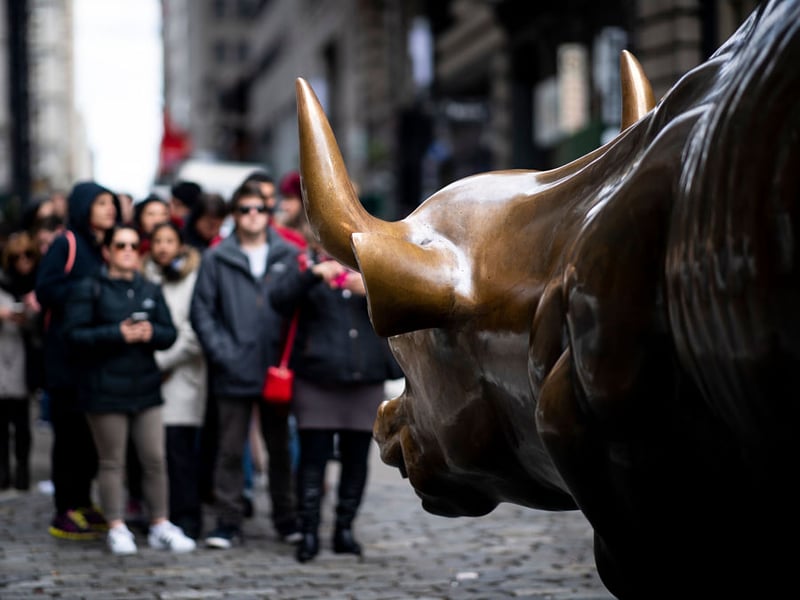As the risk of an economic slowdown lingers, exchange-traded fund investors are seeking shelter in bond funds.
They've poured about $72 billion into fixed-income ETFs this year through Friday, with the funds on track for their biggest first-half inflows ever, according to data compiled by Bloomberg Intelligence. Those bets have also fueled assets in the debt strategies to hit an all-time high of nearly $741 billion.
Markets have been whipsawed by mounting concern over softer economic data and President Donald J. Trump's trade wars with major partners. For a month now, a key part of the Treasury yield curve has been inverted — a phenomenon that's reliably predicted a recession. https://www.investmentnews.com/assets/graphics src="/wp-content/uploads2019/06/CI120187626.JPG"
Federal Reserve chairman Jerome Powell said Tuesday that the downside risks to the U.S. economy have increased recently, reinforcing
the case among policy makers for somewhat lower interest rates.
"Bond ETFs are punching way above their weight. They're having a huge year," said Eric Balchunas, an analyst with Bloomberg Intelligence. "Fixed income is the benefactor of an overall hangover from last year and nervousness about money going forward."
(More: Fed signal sends advisers into fixed-income scramble)
For the long term
That's encouraged investments in long-duration debt funds, which saw inflows of more than $8.6 billion this year through Friday, according to data compiled by Bloomberg Intelligence.
The largest in the category, the $14.4 billion iShares 20+ Year Treasury Bond ETF (TLT), has seen assets surge 65% after taking in $4.5 billion during that period. Meanwhile, the iShares 7-10 Year Treasury Bond ETF (IEF) has posted inflows of about $5.5 billion, already surpassing its previous record high in 2014.
That's an indication that investors are betting interest rates will stay lower for longer, according to Chris Gaffney, president of world markets at TIAA Bank.https://www.investmentnews.com/assets/graphics src="/wp-content/uploads2019/06/CI120188626.JPG"
"They're willing to accept the current interest rates over the long period," Mr. Gaffney said. "When you lengthen duration like that, when you're looking at the long end of the curve, obviously you're thinking that you're willing to lock in those lower rates for a longer period because you don't think interest rates are going anywhere."
Ultra-short
While the longer end of the yield curve has been a favorite pocket for bond buyers, debt investors also upped their exposures at the other extreme. In June, funds tracking securities with less than a year to maturity took in $4.8 billion, on track for the biggest month of inflows since November, according to data compiled by Bloomberg Intelligence.
BlackRock Inc.'s iShares Short Treasury Bond ETF (SHV) is on pace for a record monthly inflow of more than $4 billion, while State Street Corp.'s SPDR Bloomberg Barclays 1-3 Month T-Bill ETF (BIL) is on track to take about $850 million.
Investors are "searching for yield — it's simply a yield play," said TIAA's Mr. Gaffney. "The U.S. bond market is still the place to park funds."
(More: Fixed-income focus: Beware ending up with the 'ultra-short' straw)
In good company
Another beneficiary of a Fed willing to cut rates to boost growth are funds tracking corporate debt. The $37 billion iShares iBoxx $ Investment Grade Corporate Bond ETF (LQD) took in more than $4 billion through Friday, nearly double its previous monthly record. Meanwhile, the iShares iBoxx High Yield Corporate Bond ETF (HYG) has taken in over $3 billion in the same period.
"Investors are saying really low interest rates are fantastic for corporations because they can borrow at low rates," said Priscilla Hancock, managing director of global fixed income, currency and commodities at JPMorgan Asset Management.https://www.investmentnews.com/assets/graphics src="/wp-content/uploads2019/06/CI120189626.JPG"
But Ms. Hancock has some concerns that flows could turn negative — especially in riskier assets such as high-yield debt — as investors seek safety and exit funds to access liquidity.
"If we're in late cycle, you want to be careful about reaching for too much yield and taking on too much risk, because when you want to get out, everyone else may also want to get out at the same time," she said. "I'm concerned about where pricing will go when everyone is trying to get out of the eye of the needle."







